
20 Christian Pilgrimage Sites in Israel: The Guidebook
Israel, often called the birthplace of Christianity, is a land steeped in history, holding deep significance for believers. Christian pilgrimage sites abound in this small
What connection do Israel and diamonds have? Why does the diamond industry hold an important place in Israel’s diamond history? What about the Israeli Diamond Exchange makes it a center for international diamond trade? This article will go over the history of Israel’s massive and booming diamond industry and how it is a significant component of the success of Israel as a whole.
Israel has become a highly significant hub of the international diamond trade, with over 30% of the world’s diamonds passing through the doors of the Israel Diamond Exchange. The Israel diamond industry was established during the British Mandate in the 30s, but diamond selling is not where the Israel diamond trade started. The oldest active trade in Israel is the diamond-cutting trade. Unbeknownst to most people, even Israelis, the diamond-cutting industry put Israel on the map and solidified an economy with opportunities for growth and success even before becoming an independent state. The diamond-cutting industry started when it welcomed and provided a new or a continual career for the hundreds of new immigrants coming from war-ridden countries in the late 40s. This was Israel’s brilliant start in becoming a world leader in diamonds, from cutting, evaluating, handling, and trading.
Jewish people started working in the diamond cutting and trading industry as early as the eleventh century, where documents show that there were two Jewish brothers based in Cairo who supplied diamonds and precious stones to the Fatimid Caliph Empire. In the late 14th century, Antwerp began in the diamond industry when diamond merchants began importing diamonds, and it fostered a fertile market for Jews in the coming century.
Historically, the relationship between Jews and diamonds continued to the end of the 1400s when Jews escaped the Spanish Inquisition and successfully built the world’s then-largest diamond market in Holland and solidified Antwerp’s leadership in diamonds. During the 17th and 18th Centuries, there were significant restrictions on the opportunities for business, trade, and work for Jewish people. Combined with the long history of expulsion under Christian rule, the diamond trade was one many Jews adopted. The business was not limited to a designated place. It was quickly concealable, portable, and easily liquified. This gave a monopoly on the diamond trade during this era in Germany to the Jewish community, as apart from skill at cutting and evaluating, the insular community of the Jewish people of that time fostered a lack of risk that other diamond traders faced, whether by selling on credit, transportation of goods, or theft.

The diamond-cutting industry in Israel started when immigrants from the Dutch and Belgian communities brought over their wheels and diamond-cutting paraphernalia in the early 1920s with the hope of continuing their diamond-cutting career in a new country, but unfortunately, their machinery was put into storage, as the British Mandate made independent diamond trade nearly impossible with strict limitations on rough diamond imports, and high taxation rates.
When World War 2 hit the European countries that were the source of diamond-cutting facilities and trade, the diamond-cutting wheels in European countries became silent. De Beers found a highly skilled diamond-cutting market that was ready and waiting to be put to work in Israel. De Beers started working with Israel in the 1940s, which created an influx of work for the new immigrants and boosted Israel’s economy. They solidified their place in the international diamond industry. By the end of World War 2, the industry was doing so well that exports of polished diamonds by the end of the British Mandate averaged about $16 million.
The cutting industry in Israel paved the way for the immense diamond trade in Israel today. With approximately 80% of diamonds processed in Israel being sent to the United States and being the United States’ leading diamond supplier, 50% of diamonds purchased in the U.S. comes from Israel. Because of its significant standing in the diamond trade, The Israel Diamond Exchange is officially the world’s largest diamond exchange.
The Israel Diamond Exchange was first officially founded in late 1937 by diamantaires in Israel in preparation for the impending war. Meetings were held in private rented rooms until the Israel Diamond Exchange’s new headquarters in Ramat Gan opened. Ramat Gan is in the Tel Aviv District, and moving the Israel Diamond Exchange to this neighborhood transformed it from urban land to an industrial and modern central part of Israel. The Shimshon Tower opened in 1967, and it is the first building of the four part-complex that still stands today. When the Bourse expanded, the Israel Diamond Exchange unveiled its second and third buildings, the Noam and the Maccabi Towers. And in 1992, to give room to the ever-expanding industry, the most prominent structure of the Israel Diamond Exchange compound was constructed, and the Yahalom Tower remains the largest and most modern of the other three buildings.

The four buildings that comprise the Israel Diamond Exchange are all securely interconnected, ensuring diamantaires do not have to leave the complex with their diamonds and can find everything they might need in the vast compound. Furthermore, the buildings are all easily accessible from within the Israel Diamond Exchange to provide traders the security of moving freely between any of the four buildings without ever having to leave the secure complex for business. Bridges connect the buildings, and one of the bridges make up the floor of the International Diamond Trading Hall, the largest trading hall in the world, where international diamond traders, dealers, and brokers confer to sell and trade their wares.
With a constant influx of inventory, every type of natural diamond in every color, size, color, and shape can be found in the Israel Diamond Exchange. From fancy color diamonds to innovative diamond cuts, there is a steady supply of every single type of diamond in the Israel Diamond Exchange, making the Israel diamond center a highly attractive place for international diamond traders to come and conduct their business. Because of Israel’s highly skilled diamond cutters, some specific shapes and diamonds can only be found in the Israel Diamond Exchange. Additionally, because of the consistent amount and range of diamonds housed in the Israel Diamond Exchange, the international jewelry trade turns to Israel as a supplier to ensure smooth orders and no shortages or limitations on types of diamonds.
The vast Exchange is over 85,000 square meters and houses over 1,200 private offices. Within the Israel Diamond Exchange, there are services for members, including banks, restaurants, government facilities, and diamond processing technologies, to empower diamantaires secure trade in an enclosed space without ever having to leave the Israel Diamond Exchange with their precious stones for diamond related business. The Israeli Bourse has approximately 3,100 members who have gone through a highly secure application process to become certified members, international diamond traders, and over 15,000 employees who enter the guarded security gates each day to conduct their diamond business.

Diamond Exchanges are a non-profit organization that creates a secure environment for its traders and members to conduct their business. They are an umbrella company that services businesses and individual traders under its roof, especially in security and accessibility. The Israel Diamond Exchange runs under the concept of ‘everything under one roof’, and because of this, members can access anything they need, from business to social services. The Israel Diamond Exchange has everything, including real estate offices specializing in renting offices in the Diamond Exchange, shipping insurance companies, post offices, customs, banks, restaurants, shops, doctors, gyms, and a synagogue for services and study.
Additionally, the Israel Diamond Exchange provides advanced and sophisticated technology, and computer systems for members to use to enable transparent trade. The top Israeli technological innovations regarding diamonds can be found and utilized in the Trading Hall for members to learn about a diamond they are interested in before closing a deal. All these services, and so many more, are in place to ensure diamantaires have everything they need in proximity and without having to leave the secure environment of the Israel Diamond Exchange. To further protect its members, the Israel Diamond Exchange implements a rule that does not allow photos or videos to be captured in all the public places in the complex. This provides confidentiality and security to its members and their employees.
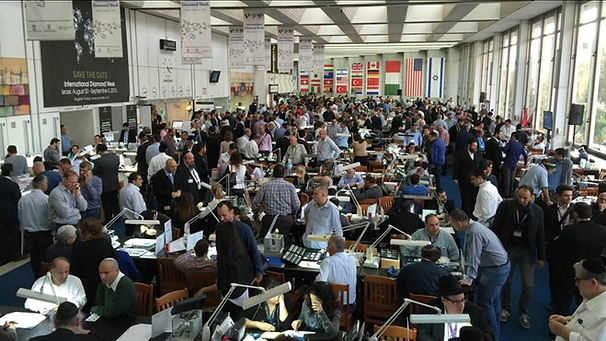
Israel’s diamonds are one of the country’s most significant exports. Although diamonds are not sourced in Israel, rough and polished diamond exports exceeded $7.3 billion in 2016. Over 30% of the world’s diamonds pass through Israel, whether to be cut and polished or traded and evaluated. Apart from being a leader in the diamond trade, the Israel Diamond Exchange has become a sort of founder of how diamond exchanges worldwide conduct their business. With a highly secure process and a display of significant success, the Israel Diamond Exchange has inspired the way diamond trades are conducted internationally.
Diamond Exchanges around the world operate solely on reputation and trust. Because diamonds are easily concealable, nearly untraceable, and easy to sell, the only way to perform such operations at such a large scale would be via reputation, guarantors, and personal references. So much so that Diamond Exchanges worldwide do not use official law enforcement courts. Instead, all Bourses and Diamond Exchanges have their own arbitration set in place, with only trusted members voted in who will act as mediators, enforcement and creator of rules, and to help further the reputation of diamond merchants.
The reputation of merchants plays out in business in a twofold manner. Firstly, in order to become an approved diamond merchant of a Diamond Exchange, the applicant will need pre-approved members to propose, advocate and guarantee that they are reliable and trustworthy. To be offered by someone with a history of bad business dealings, lack of payment, or complex transactions perpetuates that onto the new applicant and will create wariness in traders doing business with the new applicant. Secondly, should a diamond trader use their temporary possession of diamonds for theft, although the gratification will be immediate, it forever affects their ability to ever trade diamonds in every single Diamond Exchange. This may not seem to be that big of a consequence, but understanding the process of the diamond trade more will clarify how large and significant this retribution is.
As to the first point, to become an approved member of an Exchange, there need to be guarantors. As diamond businesses are mostly intergenerational and familial businesses, guarantors are usually family, or close members of a tight-knit community. Therefore, should the member conduct trades dishonestly, it affects everyone in connection to that person, including family, guarantors, business partners, etc., as well as future members of the family business and past members who have done trade, as all of their reputations from the past, till the infinite futures will forever be marred. So the one-time payment can perhaps just be enough for one lifetime but cuts off the potential traders in the next generations from ever dealing in the industry and family business.
Because of this process, Israel’s Diamond Exchange provides a highly secure environment for traders, minimizing trade risk through their very intense application, interview, and reference process. Additionally, the Israel Diamond Exchange provides arbitration to settle disputes via a group of highly trusted members voted by the traders of the Israel Diamond Exchange. Elections are held biennially for the President of the Diamond Exchange, members of the Directorate, and the control committee.
Internationally, diamond deals are not completed via written contract but rather with a handshake between two parties. Then, the Yiddish words ‘Mazal U’Bracha indicate the terms were accepted, and the deal is no longer negotiable. The Yiddish words used to seal deals are spoken by both parties for every diamond deal that takes place worldwide.

Another aspect of the running’s of the Israel Diamond Exchange is the transparency it provides to its members about dealers and traders. Should a trader wish to conduct a trade with another diamond dealer, it is straightforward to gain references and learn of the other party’s trade history and if any problems arose from their past dealings. The value of transparency is so high that prior to entering into negotiations with a new trader, members can look at a designated bulletin in the trading hall that lists the names of members who have acted dishonestly in their deals and have not yet resolved the issue.
Because of Israel’s position in the world diamond trade and the range of supply the Israel Diamond Exchange has, diamonds can be sold at close to cost price. The fewer hands the diamond has touched, the lower the price tag on the stone will be, meaning precious diamonds can be purchased in the Israel Diamond Exchange at prices that are significantly less than local jewelry stores because the Israel Diamond Exchange maintains a steady flow of supply almost directly from the mines.
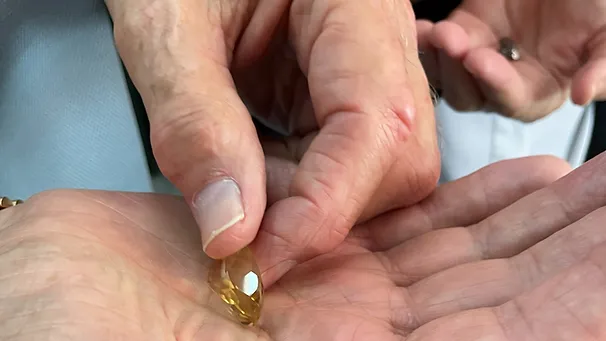
The diamond industry has built bridges for Israel with so many countries. Israel’s master skill set at cutting and polishing, to dealing with diamonds, as well as Israel’s supply of diamonds, means that Israeli Diamantaires can be found in Diamond Exchanges around the world, including in countries that do not have political alliances with Israel. Because Diamond Exchanges around the world are a unified group of organizations, Israel’s Diamond Exchange welcomes all members of all other international Exchanges to its trading hall, and the courtesies are reciprocated. The Trading Hall in the Israel Diamond Exchange is a testament to the diversity of the industry, where members are not limited to race, gender, religion, or sexual orientation. The Trading Hall is where diamantaires work together in a secure and friendly environment, dealing, brokering, selling, and trading their wares.
Entering the Israel Diamond Exchange is difficult for visitors who wish to see the enormous complex and the proceedings happening behind closed doors if they are not members. Because of the immense stock of valuables the Israel Diamond Exchange has, it is one of the most secure buildings in Israel, making entry difficult. Visitors who wish to enter need to be invited in by a pre-approved member, and they then need to provide passport identification, fingerprints, and a photo for facial recognition software. In addition, visitors are not allowed to roam freely throughout the complex but rather be escorted through the buildings, trading halls, and other venues inside the Israel Diamond Exchange by a pre-approved member to ensure the complex remains secure.
Apart from security processes, Israel has become a global leader in the quality and technique of cutting diamonds. As of 2016, Israel has cut and polished over 20% of the world’s diamonds. As the industry has modernized, Israel has added a technological compound to their work and have become the pioneer of inventing and producing machines that minimize risk and create less room for mistakes in the diamond-cutting industry. The Israeli inventions of technology and machinery like diamond cutting lasers, automatic grinders, and Computer Aided Design systems are used worldwide, increasing the production of polished diamonds.
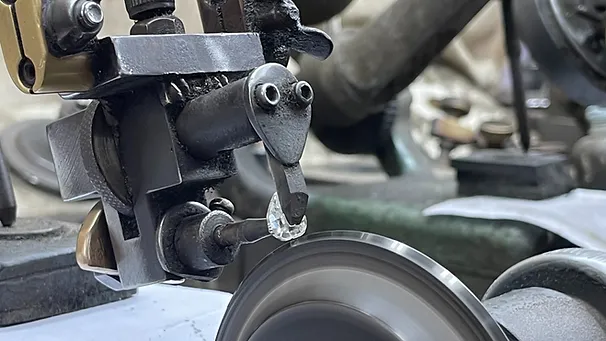
From the 1940s, the diamond cutting industry in Israel has persisted and is still prevalent today. The trade was taught from father to son, and the techniques used today have been curated to perfection. With active diamond-cutting factories scattered around the Bourse in Ramat Gan, Petah Tikvah, and Netanya, Israeli diamond cutters seek to use their skills on high-value diamonds.
Although India statistically has the lead in the diamond cutting industry, with 14/15 diamonds being cut in India, the higher cost of labor from the Israel diamond cutters is less of a factor to rough diamond traders as the skill and workmanship that goes into the cutting of diamonds in Israel add a significant percentage of value to the finished product. Additionally, when looking at India’s diamond cutting statistics, it includes pave diamonds (small decorative diamonds that usually surround a center diamond), and the cutting of these diamonds aren’t that large of a risk, and their value is significantly less than diamonds that average to be over 2 carats.
Rough diamond traders invest in the higher cost of labor of Israel’s diamond cutters when the rough stone is of high value, as the higher price tag of Israeli diamond cutters is practically irrelevant when wanting to have a diamond cut to perfection as to significantly increase its value. Because of Israeli cutter’s techniques, cutting the larger and more valuable diamonds has marketed them to the world as specialists in polishing the larger and expensive diamonds. Because of their skill, Israeli diamond cutters don’t focus on smaller, less valuable stones. Instead, they use their skill set on polishing the larger rocks and cutting diamonds into highly unique shapes and designs that no other cutting industry has yet mastered.
Interestingly, within the walls of the complex of Israel’s Diamond Exchange, there are no diamond-cutting factories. The Diamond Exchange is in the heart and center of the Israel Diamond District neighborhood. The district contains 1.1 million square meters of commercial and living space with plans to expand the community to 3.7 million square meters. The Diamond District is where all the diamond-cutting polishing and facilities in Tel Aviv are, as well as jewelry shops, restaurants, hotels, and commercial businesses. The diamond-cutting factories are not in the Israel Diamond Exchange for security purposes and to ensure that rough diamonds don’t get mixed up, as they usually have no identification before being cut, polished, and processed.
Rough diamonds, like polished diamonds are traded and sold within the Israel Diamond Exchange Trading hall to dealers who deal in the rough diamond trade. After the deal is complete, the trader will send the rough stone to a diamond cutter, who can work on a single stone for up to one week. Cutting diamonds take time as each facet of the diamond has to be cut.
Additionally, diamond cutters’ work is highly delicate to ensure no unnecessary weight is removed from the rough stone, as a decrease in weight can significantly decrease the value. The newly polished diamond will then be sent to gemological evaluators, who will issue a certificate for the stone. Once the diamond has been polished and certified, the dealer will bring it back into the Israel Diamond Exchange Trading hall to trade the now completed and much more valuable diamond. Because of the process of both rough and polished diamonds entering and exiting the Israel Diamond Exchange twice in the diamond’s journey, this contributes to the statistic and chances that 3 out of 10 diamonds have been inside Israel’s Diamond Exchange.
As time progresses, Israel’s diamond-cutting industry is fading out as the average age of Israeli diamond cutters is 60+. What once was a trade passed down from father to son, the children of diamond cutters are pursuing more lucrative careers in the diamond industry, either trade or jewelry, and this results in a lack of the newer generation learning the skills of their ancestors from generations back. Despite the diamond cutting industry in Israel thinning out, the diamond import, export, and trade are at an all-time high, and statistics show only an increase in future endeavors. The diamond cutters of generations ago paved the way for Israel to become a booming center of diamonds and have created the environment for the careers of hundreds of thousands of Israeli people in the diamond and jewelry industry, which is one of the pillars of the Israeli economy.
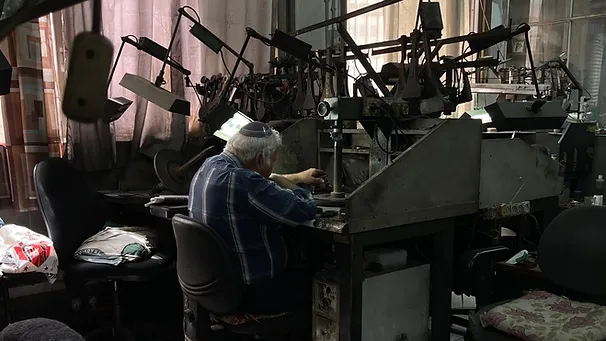
Israeli Diamond Cutter
The modern evolution of the fascinating diamond trade in Israel is a solid testament to the Israeli innovation, grit, and economy. What started as skill work in a factory has bloomed into becoming a world center for the world’s most significant and most valuable diamonds. The Israeli Diamond Industry provides careers and livelihood to over 20,000 families, and indirectly contributes to other branches of the economy, including tourism, banking, aviation, and security, and is highly responsible for creating many innovative and industrial opportunities.
Learn more about the diamond industry in Israel by going on a diamond tour of the Israel Diamond Exchange. Click here to book online!


Israel, often called the birthplace of Christianity, is a land steeped in history, holding deep significance for believers. Christian pilgrimage sites abound in this small
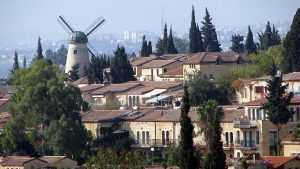
In the heart of the Middle East lies Jerusalem, a city steeped in history, culture, and religious significance. Positioned at the crossroads of civilizations, Jerusalem
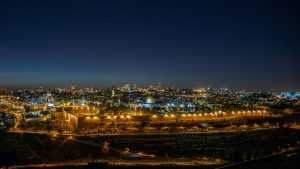
Jerusalem, a city that never sleeps, transforms into a captivating wonderland after dark. From exploring the enchanting Old City streets to indulging in local ice

Welcome to a week-long adventure in Israel! Discover what to do in Israel for a week and immerse yourself in its rich history and diverse
© 2023 Israeltours4u. All rights reserved.
